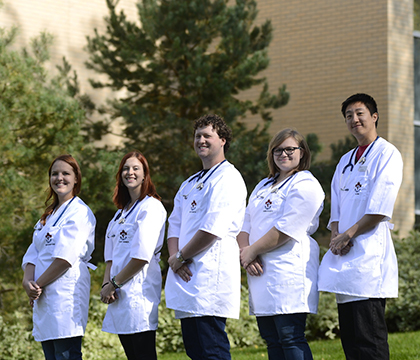
Student demographics shift at WCVM
As the Western College of Veterinary Medicine (WCVM) prepared to open its doors in 1965, Dean Larry Smith and his admissions committee pored over 93 applications and chose the WCVM's first class of 33 students.
By Lynne GunvilleSince then, the college's capacity for students has increased along with it recruitment efforts: the number of applicants has tripled in the past six decades. Today, the WCVM annually receives about 275 applications from prospective students in British Columbia, Saskatchewan, Manitoba and the northern territories. Each spring, the college selects 88 students for the first year of its four-year Doctor of Veterinary Medicine (DVM) program.
The world has changed a great deal since 1965, and so have the characteristics of the average veterinary student. A demographic study of the WCVM's graduating class of 2006 illustrated many of those changes. Probably the most dramatic change is in the ratio of male to female students. The first-year class of 1965 included only one woman, but WCVM students are now predominantly female — women now comprise more than 80 per cent of the student body.
Students' career goals have also evolved as the veterinary profession in Western Canada has shifted from mainly focusing on agriculture and food animals to including other careers in small animal and mixed animal practices and specialized clinical services for small and large animals. There are also a variety of career options in public service, public health, industry, research and academia.
While about a third of the WCVM's veterinary students come from farm backgrounds, most of them still aim for careers in food animal and mixed animal practices. Surprisingly, salary and work schedule aren't the most significant factors for students choosing their first position after graduation. Their most important considerations are the type of practice that appeals to them, the amount of support they'll receive from others within the practice and the happiness of their spouse and family.
Personal happiness and well being have become increasingly important to students. Recent studies that placed veterinary students and practitioners at high risk for mental, physical and emotional fatigue have led to an increased focus on developing skills and strategies for coping with work-related stress.
Private practitioners and WCVM faculty continue to be important influences on students. Many of them were first attracted to the veterinary profession because of early experiences with veterinarians, some have grown up around a relative who's a veterinarian, and others have benefited from volunteering or working for a practitioner or a WCVM clinician.
As the WCVM recruits applicants, the characteristics of the average veterinary student may be changing — but the ultimate goal remains the same. The college continually strives to select those individuals who will excel as veterinarians and leaders in their communities.
The WCVM is celebrating its 60th anniversary in 2025. Throughout the year, WCVM Today will post stories that highlight the WCVM's history as well as its people, programs and successes.
Visit the WCVM Turns 60 web page for more details about the college's 60th anniversary celebrations.
